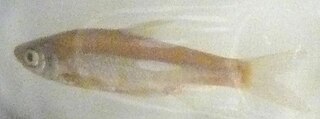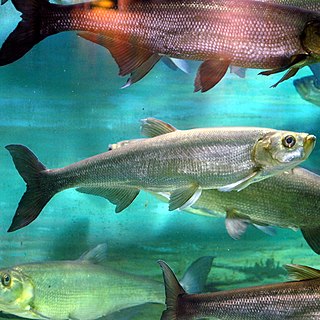
Hemiculter is a genus of freshwater ray-finned fish belonging to the family Xenocyprididae, the East Asian minnows or sharpbellies. The species in this genusare found in eastern Asia from Siberia to Viet Nam. The type species is the sharpbelly, Culter leucisculus. The name is derived from the Greek word hemis, meaning "half", and the Latin word culter, meaning "knife".

Ischikauia is a monospecific genus of freshwater ray-finned fish belonging to the family Xenocyprididae, the East Asian minnows or sharpbellies. The only species in the genus is Ischikauia steenackeri, the wataka, which is endemic to Lake Biwa in Japan. This species was originally described as Opsariichthys steenackeri.
Siniichthys bleekeri is a species of freshwater ray-finned fish belonging to the family Xenocyprididae, the East Asian minnows or sharpbellies. It originates in the Amur River, Yangtze River, and the Yellow River basins in China. It was originally described by N. A. Warpachowski in 1887 but it may be a junior synonym of Ussuri sharpbelly.
Anabarilius polylepis s a species of freshwater ray-finned fish belonging to the family Xenocyprididae, the East Asian minnows or sharpbellies. This species is endemic to Yunnan, China. It only occurs in Dian Lake and Songhuaba reservoir in Kunming. It was once a major commercial fish species, but it has not been confirmed in the lake since the 1970s. Its decline is attributed to many factors: introduced fish species, decreasing water quality, the loss of macrophytes, over-fishing, and the loss of breeding sites due to siltation and blocked access.
The white Amur bream is a species of freshwater ray-finned fish belonging to the family Xenocyprididae, the East Asian minnows or sharpbellies This is the only species in the monospecific genus Parabramis. It is native to eastern Asia, where found from the Amur River basin in Russia south to Ningbo and Shanghai in China. It is an important food fish, and has been introduced to regions outside its native range.
Anabarilius qionghaiensis is a species of freshwater ray-finned fish belonging to the family Xenocyprididae, the East Asian minnows or sharpbellies. Thisfish was known onbly from a single lake, Qionghai Hu, Xichang, Sichuan in China but it is now considered to be extinct in this lake.
Chanodichthys abramoides is a species of ray-finned fish belonging to the family Xenocyprididae, the East Asian minnows or sharpbellies. This fish is is endemic to the southern part of the lower Amur river system, including the Sungari and Ussuririvers and Lake Khanka, in Heilongjiang and Jilin provinces in China and in Amur. Primorsky Krai and Khabarovsk Krai districts in Russia.

The predatory carp, also known as the redfin culter or skygazer, is a species of ray-finned fish belonging to the family Xenocyprididae, the East Asian minnows or sharpbellies. This species ranges from the Amur River south to Taiwan and the Red River, as well as Lake Buir in Mongolia. It reaches 102 cm in length and 9 kg in weight.

Megalobrama mantschuricus, the black bream, is a species of freshwater ray-finned fish belonging to the family Xenocyprididae, the East Asian minnows or sharpbellies. This fish is found from the Amur river in eastern Russia south throug the major rivers of China to northern Viet Nam.
Hemiculter krempfi is a species of ray-finned fish in the genus Hemiculter. It is known only from the Cai River in Khanh Hoa Province and the Da Rang River in Phu Yen Province of central Vietnam. Here it is found mainly over sand substrates and is infrequently encountered in fish markets.
Hemiculter tchangi is a species of freshwater ray-finned fish belonging to the family Xenocyprididae, the East Asian minnows or sharpbellies. This species has only been recorded from the upper reaches of the Yangtze River in Sichuan.
Siniichthys varpachovskii is a species of freshwater ray-finned fish belonging to the family Xenocyprididae, the East Asian minnows or sharpbellies. This fish is found in the Khalkh River and Lake Buir in Mongolia and Lake Hulun in China. It may also occur in the upper drainage of the Argun River in Russia and China.
The smallscale yellowfin is a species of freshwater ray-finned fish belonging to the family Xenocyprididae, the East Asian minnows or sharpbellies. This species is found from the southern part of the Amur drainage systems, including the Ussuri and Lake Khanka, and along the major river drainages of China south to the Xi River in southwestern China and northern Viet Nam. The smallscale yellowfin has a maximum published total length of 70 cm (28 in). This species was first formally described in 1872 as Plagiognathus jelskii by the Polish naturalist and physician Benedykt Dybowski with its type locality given as Lake Khanka and the Ussuri River. Dybowski's genus name was objectively invalid as it was preoccuppied by Plagiognathus Fieber, 1858 in Hemiptera and in 1907 Lev Berg proposed the genus name Plagiognathops for this taxon.
Ancherythroculter daovantieni is a species of freshwater ray-finned fish belonging to the family Xenocyprididae, the East Asian minnows or sharpbellies, described in 1967. It is native to Vietnam.

Zacco chengtui or Chengdu chub is a species of of freshwater ray-finned fish belonging to the family Xenocyprididae, the East Asian minnows or sharpbellies. It inhabits Chengtu, Sichuan Province, China. It was described as Zacco chengtui in 1934 by Shigeru Kimura.
Xenocyprioides carinatus is a genus of freshwater ray-finned fish belonging to the family Xenocyprididae, the East Asian minnows or sharpbellies. It inhabits Longzhou in China's Guangxi province and has a maximum length of 4.0 centimetres (1.6 in). It is considered harmless to humans.
Xenocyprioides parvulus is a species of freshwater ray-finned fish belonging to the family Xenocyprididae, the East Asian minnows or sharpbellies. It inhabits Qinzhou, Guangxi province, China, and has a maximum length of 2.5 centimetres (0.98 in). It is considered harmless to humans.
Xenocypris fangi is a species of freshwater ray-finned fish belonging to the family Xenocyprididae, the East Asian minnows or sharpbellies. It has a maximum total length of 20.0 centimetres (7.9 in) and a common standard length of 17.0 centimetres (6.7 in). It inhabits the upper Yangtze and is considered harmless to humans.
Xenocypris macrolepis, also known as the yellowfin, is a species of is a genus of freshwater ray-finned fish belonging to the family Xenocyprididae, the East Asian minnows or sharpbellies. The fish is found in the Amur River and Vietnam. The fish is usually 10 cm (3.9 in) long (SL), the largest specimen of the fish ever recorded was 34.6 cm (13.6 in) long (SL).
Siniichthys is a genus of freshwater ray-finned fish belonging to the family Xenocyprididae, the East Asian minnows or sharpbellies. These fishes are found in East Asia.





